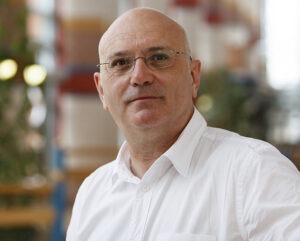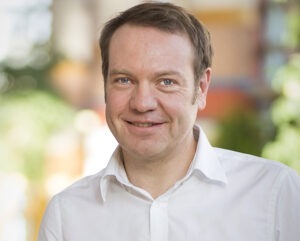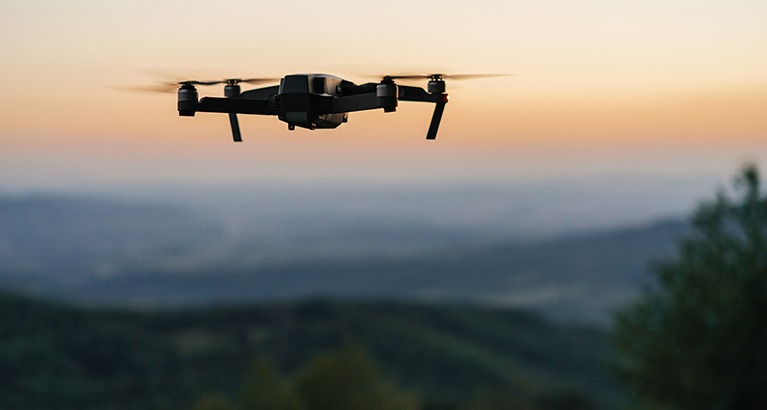“We argue that the symbiotic relationship between universities, industries, entrepreneurship, governments and the military – what we call an ever-more-invasive ‘military-innovation complex’ – sits in the blind spot of organisational scholars and deserves greater scrutiny,” says Neil Stott, co-author of research at Cambridge Judge Business School that encourages close examination of how military innovation works in practice.
“Increased attention to military innovation is important as it has a far-reaching impact on organisations and society as a whole,” adds Neil, Management Practice Professor of Social Innovation and Co-Director of the Cambridge Centre for Social Innovation (CCSI) at Cambridge Judge. “We need to strengthen democratic checks and balances on such military innovation, and this can happen through greater direct academic involvement in such activities – and we propose a 3-party typology for this based on ideas, organisational work and inter-organisational work.”
The research on military innovation reflects a 2025 paper written by Neil, Hidden Organisational Lethality, that forms part of the Critical Perspectives in Social Innovation series of the CCSI. That paper argues that there is widespread lethality in companies and other organisations that kills people, species and the biosphere intentionally, unintentionally or indirectly, and this needs to be recognised and addressed.
“Researchers in academic fields ranging from neuroscience to engineering are already being absorbed, knowingly or not, into the military’s encompassing tendencies,” says Neil. “While fewer people serve in the military in this era, ever more people serve the military in deadly innovation work, knowingly or not. So we believe that organisational scholarship should be involved far more directly in military innovation: similar to the famous quote that ‘war is too important to be left to the generals’, military innovation and its opaque processes are too important to be left unexamined by scholars and others who can provide needed scrutiny.”
Increased attention to military innovation is important as it has a far-reaching impact on organisations and society as a whole.
Why opaque networks of state, military, academia and industry demand greater oversight
Whereas then-US President Dwight Eisenhower in 1961 famously coined the term ’military-industrial complex’ to warn against undue influence from the relationship between the US armed forces and big business, the research from Cambridge Judge introduces the term ‘military-innovation complex’ to convey the concept of an opaque interaction of state, military, academic and commercial actors (including innovation hubs such as Silicon Valley) which could and should work more coherently and more transparently to drive innovation work.
“This blind spot deserves greater attention for 2 key reasons,” says the research. “First, because the opaqueness of the relationships involved – between universities, the technology industry, commercial entrepreneurship, governments and the military – undermines effective engagement in innovation. Second, because without appropriate oversight, democratic control over this complex is rendered impossible.”
Other co-authors of the research, besides Neil, are Jarrod Pendlebury, Research Fellow at the Cambridge Centre for Social Innovation and Paul Tracey, Professor of Innovation and Organisation at Cambridge Judge and Co-Director of the CCSI.
The research complements other military-focused activities of the CCSI, including the Peaceshaping and Climate Lab, which focuses on collaborative action to address overlaps between climate change and human conflict. Besides Jarrod, Research Fellows at CCSI include William (Bill) DeMarco, a command pilot and Colonel USAF (ret) who is an Assistant Professor at the Air Command and Staff College (ACSC), Maxwell AFB, Alabama.
The research at Cambridge Judge defines military innovation as involving the “creation, implementation and diffusion of ideas; organisational forms; and technology to deliver competent and coherent violence”, and the “ability to sustain lethality in the face of the chaos of combat” even for militaries that view themselves as well trained and equipped with the very latest armaments. Yet the authors point out the lack of idea movement in the other direction – from the military to organisational learnings applicable to non-military organisations and situations.




A 3-level framework to bring organisational scholarship to the military
The research at Cambridge Judge outlines how, especially in the US, research related to the military has moved from a top-down approach in Eisenhower’s day to a more decentralised military innovation ecosystem, and this intensified after the 11 September 2001 attacks in the US and the occupation of Iraq. For example, the US Army’s so-called Mad Scientist Initiative brings together military, corporate and academic communities to problem-solve about the future of armed conflict – but this diffusion has resulted in what the researchers term “multiple points of convergence, and more opaque relationships between military framing and application of scholarship.”
This presents, say the authors, an opportunity to make these relationships less opaque, so they propose a framework for military innovation work based at 3 levels:
- idea
- organisational work
- inter-organisational work
“These 3 levels provide a framework of analysis in which discussion about military innovation can be situated,” says Paul. “In so doing we can compare discussions in military and organisational studies, with an aim to bridge existing literature and thus identify themes in military innovation studies that chime with discussions in organisational theory. This can hopefully stimulate areas for future collaboration and research.”
The 3 levels outlined in the research are:
1
Idea work
Defined as the process of generating or resisting ideas on innovation
An area identified as having the most potential is the participation of user organisations or end users in developing products or services, because in military contexts it “offers an understanding of the ‘micro-processes’ involved in generating ideas” such as processes on the scale of individuals or teams, say that authors.
An example of such innovation is found in the war in Ukraine, through the Ukrainian Army’s leveraging the use of cheap and plentiful drone capabilities to demonstrate the power of tactical and operational level innovation.
2
Organisational work
The process of organisational action to deliver or resist innovation.
The research defines this work as the “process of organisational action to deliver or resist innovation”, and focuses on how organisational learning has become central to military scholarship debates – because “militaries that do not learn, or cannot integrate learning rapidly enough in combat, tend to suffer”.
Among areas identified as ripe for further research is how military organisations create space for more decentralised and collaborative organisational learning, how they learn under duress, and how they manage the tension between innovation and continuity.
3
Inter-organisational work
The process of inter-organisational action to deliver or resist innovation.
While there has been research into how organisations like NATO have achieved collective objectives including successful wars, they have tended to focus on command issues that offer limited insights relevant to other fields.
“A better understanding of military inter-organisational work could contribute to organisational theory, offering insights relevant to other fields,” the authors say. “Collaborative research into military ‘inter-organisational work’ is especially urgent. The nature of climate-related crises likely to assail us in the not-too-distant future means the ability of organisations to cooperate without conflict will be crucial.”
Military innovation should help prevent conflict, not just boost firepower
In conclusion, the authors ask how military innovation could contribute to reducing the likelihood of conflict rather than, as mostly the case now, simply boosting the effectiveness of battlefield operations and the lethality of armaments.
“Put another way, how can military innovation support whole-of-government stabilising activities that deter international actors from initiating conflict?” the research asks, arguing that such innovation could better achieve such broader aims through research that brings more transparency into how military innovation works in practice.
Featured people
Neil Stott
Management Practice Professor of Social Innovation
Paul Tracey
Professor of Innovation and Organisation
Jarrod Pendlebury
Research Fellow at the Cambridge Centre for Social Innovation
Featured research
Stott, N., Pendlebury, J. & Tracey, P. (2025).”Organising military innovation: Collaborative opportunities for organisational and military innovation scholars”. Contemporary Issues in Air and Space Power (forthcoming)
Stott, N. (2025) “Organisational lethality/organisational vitality – part 1: hidden organisational lethality: the existential challenge for social innovation.” Critical Perspectives on Social Innovation, No.2025/3. Cambridge: Cambridge Centre for Social Innovation.
Cambridge Centre for Social Innovation
The Cambridge Centre for Social Innovation (CCSI) is one of the research centres at Cambridge Judge Business School. The centre builds best practices across business, civil society, policy and academia for a more sustainable world.





